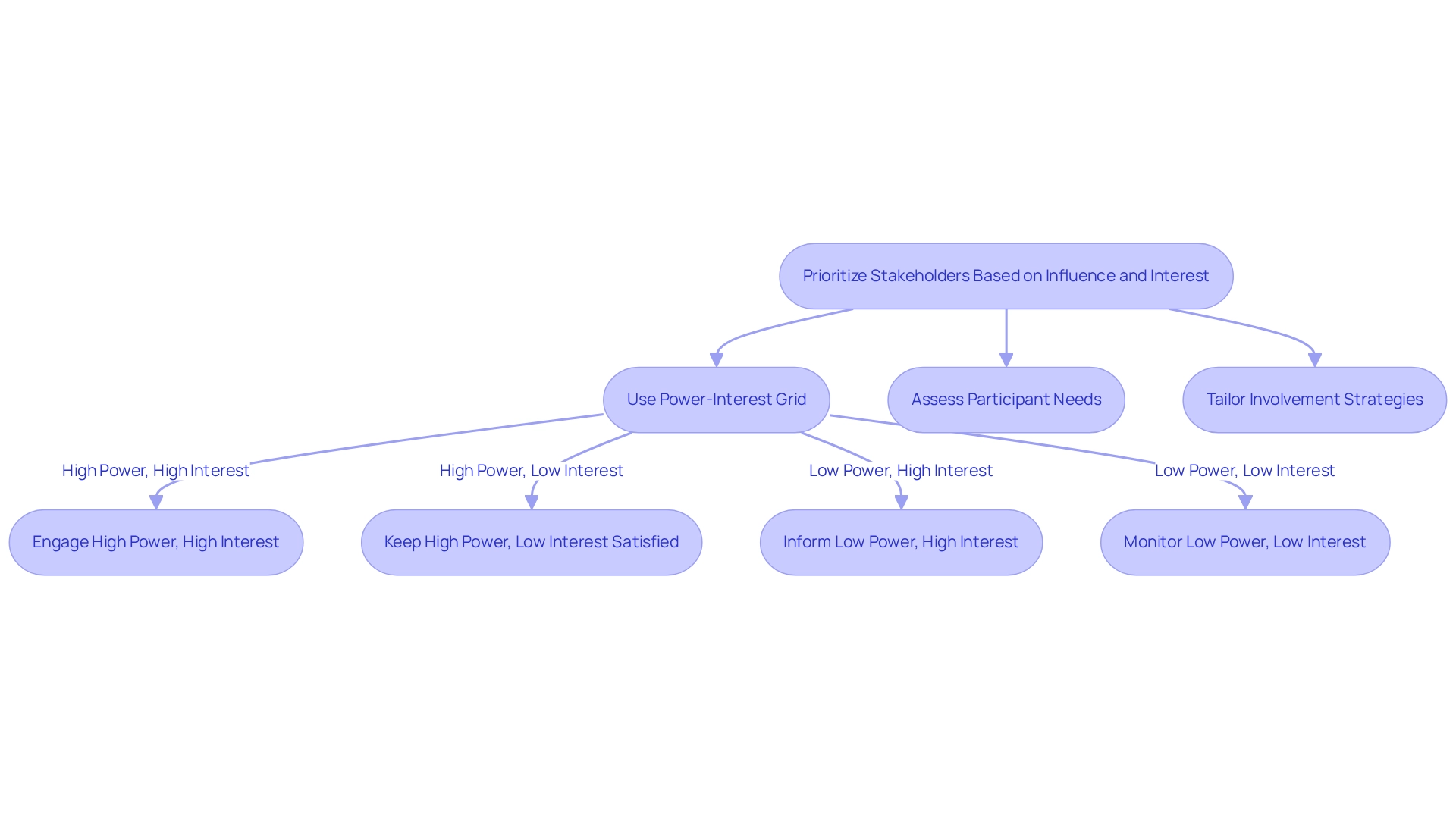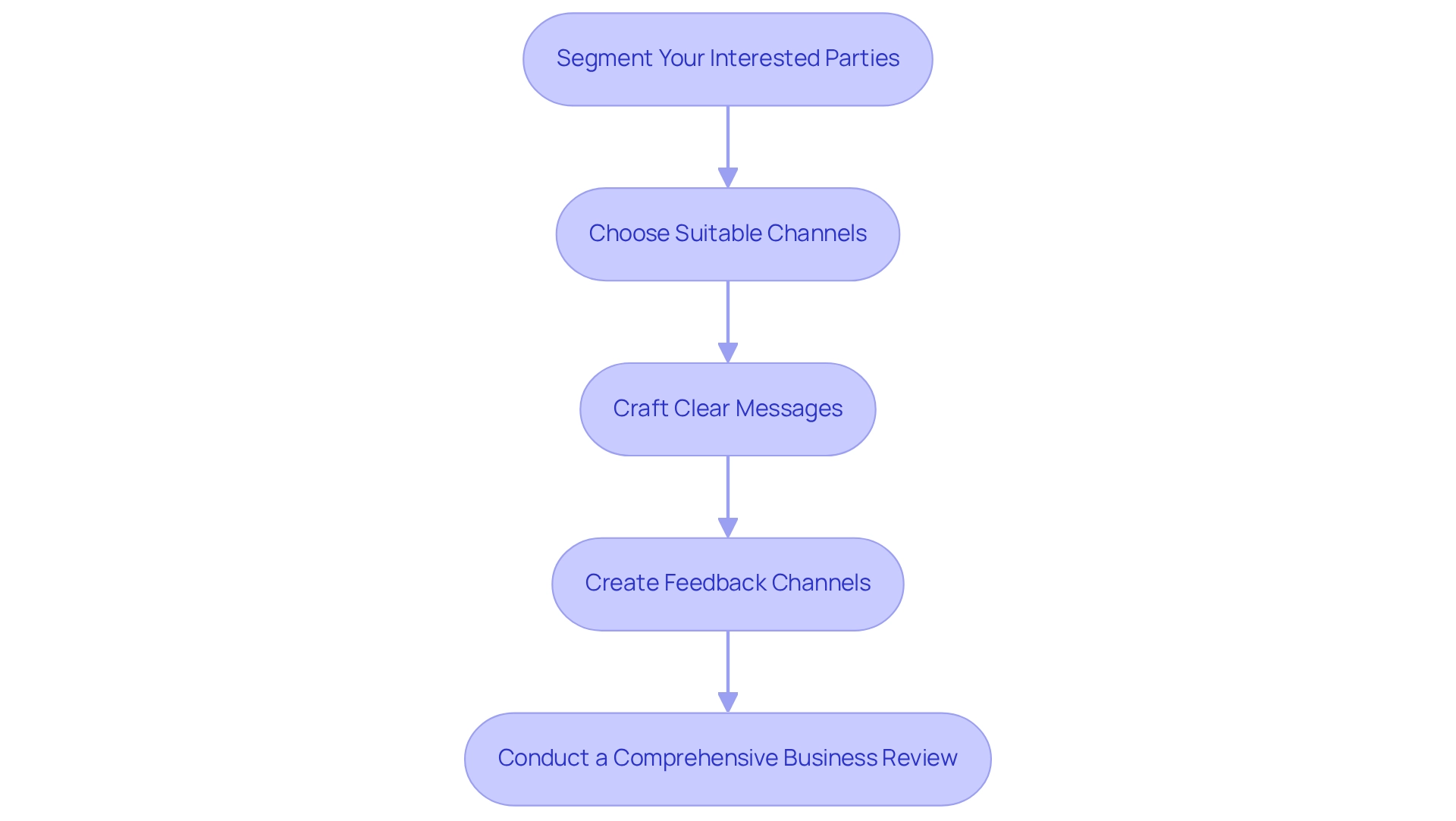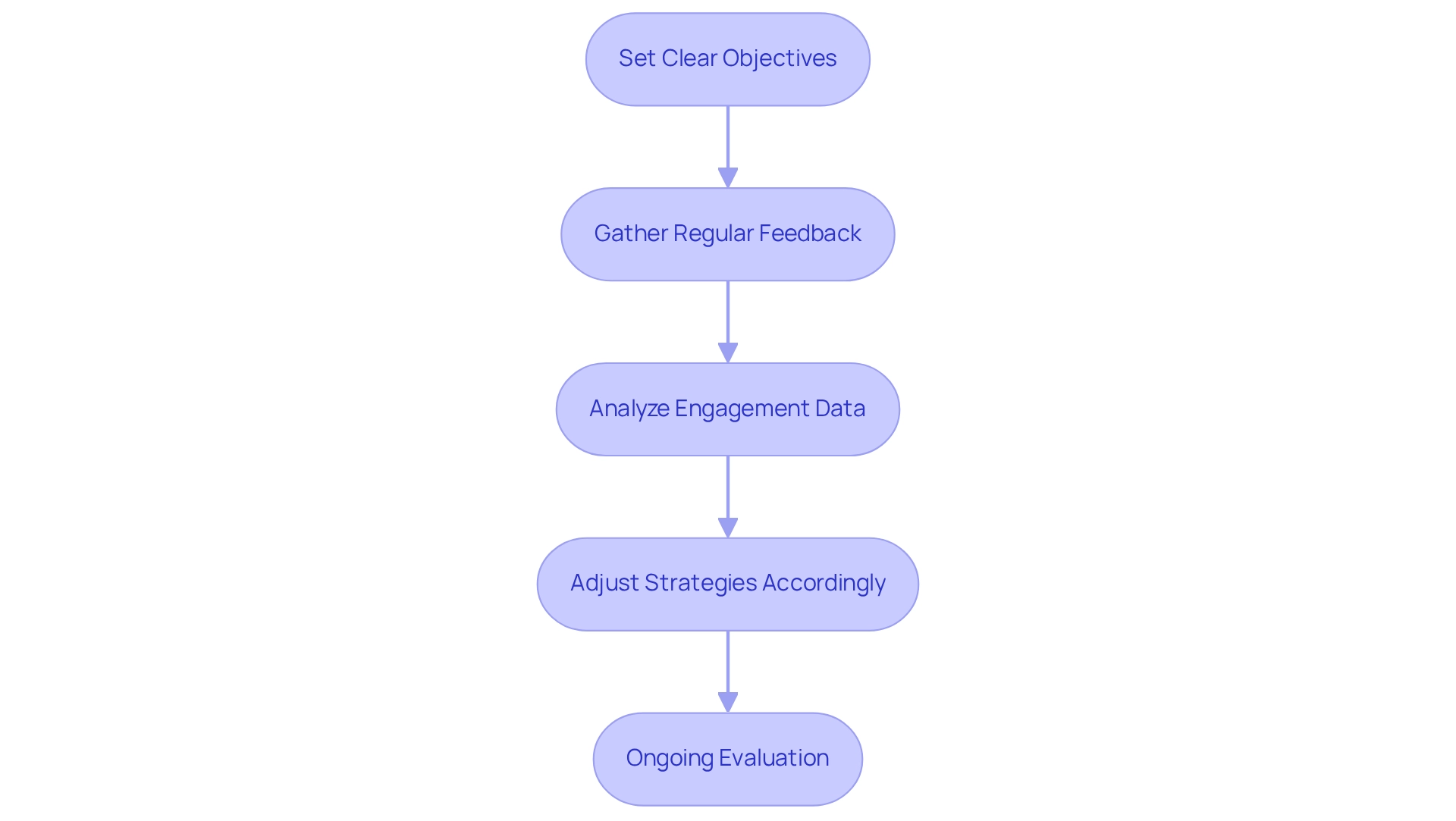Overview
The 4 Cs of stakeholder management—Communication, Collaboration, Coordination, and Control—are essential for achieving financial success by fostering effective relationships with stakeholders. Organizations that prioritize these elements not only enhance engagement but also streamline processes, leading to substantial profit increases.
Data reveals a remarkable 20% rise in profits linked to effective stakeholder communication. Consequently, prioritizing the 4 Cs is not merely beneficial; it is imperative for organizations aiming to thrive in today's competitive landscape.
Introduction
In the intricate landscape of organizational dynamics, effective stakeholder management stands as a crucial pillar for success. The 4 Cs framework—Communication, Collaboration, Coordination, and Control—forms the cornerstone for nurturing strong relationships with stakeholders, ensuring their voices resonate and are actively woven into decision-making processes.
By identifying key stakeholders and prioritizing their engagement based on influence and interest, organizations can customize their strategies to address diverse needs. This article explores the fundamental components of stakeholder management, providing actionable insights on:
- Enhancing communication strategies
- Monitoring engagement
- Adapting approaches within a continually evolving business environment
As the significance of collaboration escalates, mastering these principles becomes essential for fostering sustainable growth and propelling organizational success.
Define the 4 Cs of Stakeholder Management
The 4 Cs of stakeholder management—Communication, Collaboration, Coordination, and Control—are essential for fostering effective connections with involved parties, where establishing transparent and open lines of dialogue is vital. This guarantees that the interests and concerns of all parties are not only acknowledged but also attended to, resulting in a more involved and content group of contributors. Firms that emphasize efficient exchange of information can see a 20% rise in profits, underscoring its direct influence on financial success. Moreover, using real-time analytics can improve communication strategies by offering prompt feedback on participant interactions.
Collaboration: Involving interested parties in a cooperative manner nurtures a sense of partnership and shared responsibility. This approach not only strengthens relationships but also brings parties together towards common goals, enhancing overall project outcomes. By operationalizing lessons learned from previous turnaround processes, organizations can build stronger, lasting relationships with stakeholders.
Coordination: Effective collaboration among participants is crucial to avoid duplication of efforts. By aligning objectives and strategies, organizations can streamline processes and ensure that all parties are working cohesively towards shared outcomes. The application of real-time business analytics can enhance this coordination by offering insights into participant involvement and performance metrics.
Control: Implementing robust mechanisms to monitor participant engagement is essential. This guarantees that interactions stay productive and in harmony with organizational objectives, promoting ongoing enhancement in management practices. Ongoing observation via client dashboards enables organizations to assess business health and modify approaches as required, and mastering the 4 Cs of stakeholder management can greatly improve management practices. For instance, a case study on participant engagement metrics emphasizes the importance of establishing clear metrics to measure success, such as attendance rates and feedback scores. This data-focused method enables organizations to monitor interactions and enhance communication strategies, ultimately resulting in improved project results.
In 2025, the significance of collaboration in managing interested parties continues to increase, as organizations acknowledge that their employees are their greatest resource. By nurturing a culture of cooperation and employing real-time analytics, companies can establish an atmosphere where participants feel appreciated and involved, promoting sustainable growth and achievement.
Identify Key Stakeholders in Your Organization
Identifying key participants in your organization is essential for effective management and engagement within the 4 c of stakeholder management. To enhance this process, we initiate a thorough business review to align important parties and gain a deeper understanding of your organization. Follow these steps to ensure a comprehensive approach:
- List All Potential Stakeholders: Begin by compiling a detailed list of individuals and groups with an interest in your organization. This encompasses employees, customers, suppliers, investors, and community members.
- Assess Their Influence and Interest: Evaluate each party's influence and interest using a matrix. Categorize them based on their power to affect outcomes and their interest in your projects. This evaluation is crucial, as companies that interact effectively with interested parties can experience a 20% increase in profits.
- Engage with Stakeholders: Conduct interviews or surveys to gather insights about their expectations and concerns. Understanding their perspectives allows you to prioritize their needs and foster stronger relationships. Keep in mind, 39% of social media users anticipate prompt replies, underscoring the necessity for swift interaction approaches among all participant groups.
- Create a Participant Map: Visualize your contributors with a map, clarifying relationships and influence dynamics. This tool is essential for planning your interaction strategies effectively. Furthermore, consider utilizing email newsletters to keep outside parties informed about company updates, ensuring consistent interaction.
By implementing these steps, organizations can enhance their management practices for involved parties by focusing on the 4 c of stakeholder management, ensuring consistent communication and engagement that prevents information gaps. As noted by experts, effective management of involved parties is key to navigating challenges and achieving sustainable growth. Involving underused participants in high-value projects, as illustrated in the case study 'Waiting to be Shaped and Deployed: Lower Voice and Value,' can promote their growth and enhance their contributions to the organization. As Emmanuel Acquah states, "Effective management of interested parties ensures consistent communication channels that keep them informed and engaged, preventing information gaps."
For more details on how to effectively manage your partners and enhance your business performance, let's discuss! Reach out to Transform Your Small/ Medium Business today.

Prioritize Stakeholders Based on Influence and Interest
To effectively prioritize interested parties, adhere to these essential steps:
-
Utilize a Power-Interest Grid: Map participants on a grid according to their power and interest levels. This visual tool clarifies which stakeholders warrant the most attention:
- High Power, High Interest: Engage closely and manage actively to foster strong relationships.
- High Power, Low Interest: Keep satisfied with regular updates, but avoid overwhelming them with details.
- Low Power, High Interest: Ensure they are informed and engaged, as their support can be valuable.
- Low Power, Low Interest: Monitor these stakeholders with minimal effort, focusing resources where they matter most.
-
Assess Participant Needs: Identify the specific requirements of each participant group and evaluate how these align with your organization’s objectives. Comprehending these needs is essential for effective interaction and can help reduce risks. Ongoing business performance tracking via real-time analytics can offer insights into participant sentiments and needs, thereby improving involvement strategies.
-
Tailor Involvement Strategies: Adapt your communication and involvement approaches based on prioritization. High-priority parties should receive timely updates and be involved in key decision-making processes. Streamlined decision-making, backed by real-time business analytics, can greatly enhance project success rates; studies indicate that projects with strong participant involvement achieve a success rate of 78%, compared to just 40% for those with minimal involvement. Furthermore, establishing trust with interested parties can lead to a 10% improvement in employee retention, underscoring the broader impacts of effective relationship management.
By implementing these approaches, organizations can cultivate trust and maintain robust connections with involved parties, ultimately leading to enhanced project outcomes and sustainable development. Efficient management of interested parties through the 4 c of stakeholder management, informed by lessons from the turnaround process, is critical for successful projects and should be prioritized by CFOs, who must focus on the quality of interaction and sustaining strong relationships with leaders to secure ongoing support for their initiatives.

Develop Tailored Communication Strategies for Stakeholder Engagement
To develop tailored communication strategies for effective stakeholder engagement, consider the following steps:
- Segment Your Interested Parties: Categorize participants according to their interests, influence, and preferred methods of interaction. This segmentation enables more personalized and impactful interactions, enhancing overall engagement. Business segmentation frameworks can assist in comprehending parties involved as both business executives and individuals, ensuring that messaging strategies are suitably customized.
- Choose Suitable Channels: Determine the most efficient means of interaction for each group of interested parties. For instance, high-level participants may favor formal reports, while operational teams might respond better to regular meetings or informal updates. Aligning messaging techniques with participant preferences is essential for enhancing involvement and information sharing. As emphasized in the client interaction process at Transform Your Small/Medium Business, organizations that match their messaging approaches with participant preferences experience enhanced engagement results.
- Craft Clear Messages: Formulate messages that are concise and relevant to each group. Use language that resonates with their specific interests and concerns, ensuring clarity and understanding.
- Create Feedback Channels: Set up pathways for involved parties to offer input on your messaging approaches. This could involve surveys, focus groups, or one-on-one discussions, allowing for continuous refinement of your approach. As Winston Churchill observed, it takes bravery to listen, which is vital for cultivating robust relationships with involved parties.
- Conduct a Comprehensive Business Review: Begin by reviewing your business operations to identify underlying issues and areas for improvement. This process not only informs your communication approaches but also aligns them with the strategic planning necessary for effective involvement of interested parties.
By adhering to these principles, organizations can enhance their management efforts through the 4 c of stakeholder management, ultimately leading to better financial results and promoting a collaborative atmosphere. Remember, as Babe Ruth emphasized, a team's success hinges on how well they work together. As the saying goes, "If you want to go fast, go alone. If you want to go far, go together," emphasizing the significance of teamwork in involving interested parties.

Monitor and Adapt Stakeholder Engagement Strategies
To effectively oversee and adjust your participant involvement strategies, consider the following steps:
- Set Clear Objectives: Clearly define what achievement looks like for your audience involvement efforts. This may encompass metrics such as participant satisfaction, involvement levels, or project support. Establishing these objectives is crucial, as 82% of executives believe that data-driven decision-making improves business outcomes. Conveying the purpose and advantages of measurement to interested parties is vital to guarantee their comprehension and support.
- Gather Regular Feedback: Implement consistent check-ins with interested parties to assess their satisfaction and gather insights on your engagement strategies. Utilize surveys, interviews, or informal discussions to collect this feedback, ensuring that you capture a comprehensive view of participant sentiment.
- Analyze Engagement Data: Review the collected data to identify trends and areas for improvement. Look for patterns in participant responses that may indicate evolving needs or concerns. For example, tracking essential performance indicators (KPIs) such as Customer Satisfaction (CSAT) and Net Promoter Score (NPS) can offer valuable insights into success metrics related to interested parties. Furthermore, utilizing real-time business analytics via a client dashboard can improve your comprehension of partner dynamics, ultimately leading to better interaction results.
- Adjust Strategies Accordingly: Based on the feedback and analysis, make necessary adjustments to your engagement strategies. This could involve changing communication methods, revising messaging, or reallocating resources to better meet the needs of involved parties. Involving neglected participants in high-value projects—like initiatives that align with their interests and expertise—can promote their growth and improve their contributions to the organization. Ongoing evaluation of your approaches via the client dashboard can assist in assessing business health and implementing lessons learned from turnaround efforts. As Simon Mainwaring noted, companies must recognize that shareholders should also view themselves as stakeholders in the well-being of society, and by applying the 4 c of stakeholder management within the 'decide and execute' framework, organizations can ensure that their stakeholder engagement strategies remain effective and responsive to the needs of all parties involved.

Conclusion
Mastering the principles of stakeholder management through the 4 Cs—Communication, Collaboration, Coordination, and Control—provides organizations with a robust framework for nurturing vital relationships. By prioritizing effective communication, stakeholders feel heard and valued, leading to increased satisfaction and engagement. Collaborative efforts help align interests and foster shared goals, while coordinated strategies streamline processes and enhance overall efficiency. Control mechanisms ensure that stakeholder interactions remain productive and aligned with organizational objectives.
Identifying and prioritizing key stakeholders based on their influence and interest is essential for tailoring engagement strategies. By employing tools like the Power-Interest Grid, organizations can focus their resources where they matter most, ensuring that high-priority stakeholders receive the attention and information they need. Moreover, developing tailored communication strategies and continuously monitoring engagement efforts allows organizations to adapt to evolving stakeholder needs, driving better outcomes and fostering a culture of collaboration.
In a constantly changing business landscape, effective stakeholder management is not just beneficial; it is imperative for sustainable growth and organizational success. By implementing these strategies, organizations can create an environment where stakeholders are actively engaged, leading to improved project outcomes and a stronger foundation for future initiatives. Embracing the 4 Cs and prioritizing stakeholder relationships will ultimately pave the way for long-term success and resilience in an ever-evolving marketplace.
Frequently Asked Questions
What are the 4 Cs of stakeholder management?
The 4 Cs of stakeholder management are Communication, Collaboration, Coordination, and Control. These elements are essential for fostering effective connections with involved parties.
Why is communication important in stakeholder management?
Communication is vital because it establishes transparent and open lines of dialogue, ensuring that the interests and concerns of all parties are acknowledged and addressed. Efficient information exchange can lead to a 20% rise in profits.
How does collaboration benefit stakeholder management?
Collaboration nurtures a sense of partnership and shared responsibility among interested parties, strengthening relationships and aligning them towards common goals, which enhances overall project outcomes.
What role does coordination play in stakeholder management?
Coordination helps avoid duplication of efforts by aligning objectives and strategies among participants, streamlining processes, and ensuring all parties work cohesively towards shared outcomes.
What is the significance of control in stakeholder management?
Control involves implementing mechanisms to monitor participant engagement, ensuring productive interactions that align with organizational objectives and promote ongoing enhancement in management practices.
How can organizations assess stakeholder influence and interest?
Organizations can evaluate stakeholder influence and interest using a matrix to categorize them based on their power to affect outcomes and their interest in projects.
What steps can organizations take to engage with stakeholders effectively?
Organizations can engage with stakeholders by conducting interviews or surveys to gather insights about their expectations and concerns, which helps prioritize their needs and foster stronger relationships.
What is a participant map and its purpose?
A participant map visualizes contributors, clarifying relationships and influence dynamics, and is essential for planning interaction strategies effectively.
How can real-time analytics improve stakeholder management?
Real-time analytics can enhance communication strategies by providing prompt feedback on participant interactions and offering insights into involvement and performance metrics.
What is the long-term significance of collaboration in stakeholder management?
The significance of collaboration continues to increase as organizations recognize that their employees are their greatest resource, promoting a culture of cooperation that leads to sustainable growth and achievement.




